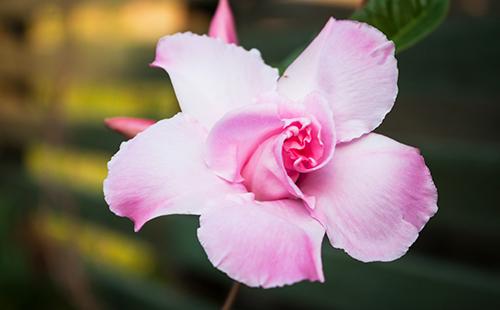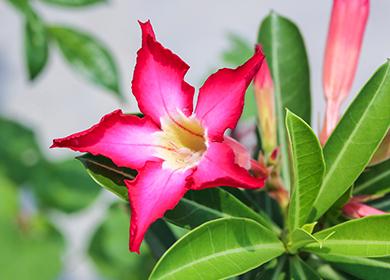The content of the article
Florists called Mandeville the queen of indoor vines, home clematis. The plant is characterized by rapid growth, abundant flowering. Quickly braids around the proposed supports, looks elegant and catchy in any interior.
What looks and interesting features
Mandeville is a shrub with flexible shoots. Their length varies from one to three meters. The size of the plant depends on the variety, conditions of detention, formation. It grows actively, quickly grows thin, smooth shoots.
The leaves are dark, rather large, with a glossy surface. The shape is rounded, with slightly pointed ends. Mandeville blooms profusely, continuously. The flowers are funnel-shaped, large, five petals elegantly bend back. From the flowers comes a gentle, pleasant aroma.
The color is different - pastel or bright. A distinctive feature is very clean shades. In addition to the main varieties, many beautiful hybrid varieties with expressive colors and improved characteristics have been bred.
Popular views for indoor floriculture
The genus Mandeville has about 200 varieties. All of them belong to climbing vines, easily cling to their supports with a mustache. Five species are best known as indoor crops.
- Mandeville loose. Thin vines reach four meters in length. Leaves are two-tone: green from the outside, purple or gray from the inside. The flowers are large, white or cream. A yellow spot is always present in the depths of the funnel. Flowers are collected in a kind of brush.
- Mandeville Sander. Beautiful liana with flexible shoots of three meter length. The leaves are small, leathery. During flowering, brushes of star-shaped flowers form. The main color is pink, with a yellow pharynx. Based on the species, breeding varieties with other colors - red, neon pink are bred. Varieties with expressive terry flowers are found.
- Mandeville brilliant. The leaves are very large, with a pronounced gloss. It blooms very abundantly - sometimes the stems are completely hidden under the flowers. The color is pink, in different shades and degrees of saturation. Among the breeding varieties there are specimens with yellow flowers.
- Mandeville Bolivian. In indoor floriculture is quite rare. It resembles Mandeville Sander in terms of characteristics. It differs from it by smaller fragrant white flowers collected in a brush. Leaves are pointed at the ends.
- Mandeville excellent. Shoots have a reddish tint, slightly pubescent. The leaves are small, the flowers are red or saturated pink, with reddish bracts.
Caring for Mandeville: Subtleties and Tips
Like all creepers, mandeville requires a special approach. Her growth should not be allowed to drift. The true decorativeness of the flower is revealed only in favorable conditions, with proper care. How to care for mandeville?
- Lighting. In nature, mandeville grows in sunny places. The apartment requires bright lighting, but does not respond very well to the open sun. You can keep the mandeville on the south window, provided that it is shaded at noon. Lack of light leads to a decrease in flowering intensity or its absence.
- Temperature. In summer, prefers moderate heat: 23-25 ° C. It reacts negatively to heat. In winter, it needs a rest period at a low temperature - it is gradually brought up to 12-15 ° С.
- Watering. In summer you need to water abundantly, immediately after the drying of the top layer of soil. Due to the large green mass, Mandeville intensively evaporates moisture. During wintering, the need for moisture is low. It is rarely watered - after the soil has completely dried up. It is useful to add a small amount of citric acid to the water for irrigation - a small pinch per liter of water.
- Humidity. Maintain stable high humidity at 70%. Spraying daily, if possible - several times a day. In winter, they continue to spray if the mandeville stands in close proximity to heating appliances. Additionally, humidity is increased by installing special humidifiers.
- Top dressing. Fertilizers are applied from March to September. The recommended feeding interval is ten days. During flowering, you can additionally feed with special means. Mostly mineral fertilizers are used.
- The soil. Soil for mandeville is chosen nutritious and loose. Good composition: leafy earth, turf, humus, sand and some clay. At the bottom, a drainage layer up to a third of the volume of the pot is required.
- Transfer. Transplant Mandeville (diplomacy) is enough once every few years. They focus on the state of the root system - if small roots make their way through the drainage holes, it's time to transplant. Young specimens are transplanted annually.
Breeding methods
Mainly propagation of mandeville by cuttings, processes. Seeds obtained from your plant are usually not used. Hybrid varieties of mandeville during seed propagation lose their vivid characteristics - the flowers become smaller, become faded.
Cuttings
Mandeville cuttings can be rooted throughout the growing season. But spring cuttings give the best results. Cutting and rooting of cuttings is carried out in six stages.
- Cut apical cuttings, be sure to leave one or two pairs of leaves. The slice is made slightly beveled.
- Leaves are cut in half.
- For a day, the cuttings are put in a solution of the drug - "Epin", "Zircon" or root forming agent is suitable.
- Cuttings are buried on the leaves in light soil. Soil - peat mixed with sand or perlite.
- The container with cuttings is closed with a film, left in a warm place at a temperature of 25 ° C. The greenhouse is aired daily, soil moisture is checked.
- After the appearance of signs of growth, the shelter is removed. After a couple of months, they are transplanted into separate containers - three cuttings per pot.
Seed cultivation
If you have well mastered the features of caring for mandeville (dipladenia), you can try to grow it from seeds. But even experienced flower growers note the complexity of this method of growing. Seeds germinate poorly, seedlings are tender, easily die. They need a special, attentive care. Seed cultivation is carried out in six stages.
- For about a day, the seeds are kept in warm water with the addition of the Epin preparation.
- A mixture of peat and sand is used as a substrate. The substrate is pre-sterilized - heated in a pan and watered with potassium permanganate.
- Wet soil is poured into a low wide container, level it. Distribute seeds on the surface, cover with a thin layer of the same substrate, spray from the spray gun.
- The container is covered with a transparent film, put in a warm, bright place. Seeds germinate only at high temperatures: 25-30 ° C. Therefore, it is advisable to use a greenhouse with bottom heating. Temperature differences negatively affect germination.
- The first sprouts appear only after a month. It will be possible to seed them after the formation of the first pair of real leaves. Seedlings protect from direct sun, drafts, often sprayed, monitor the moisture of the soil. Any violation of the rules of care at an early stage of development of seedlings leads to their death.
- When the height of the seedlings reaches 10 cm, carry out the next transplant. Two to three sprouts are usually planted in one pot at once.
Content errors and their consequences
Errors in caring for mandeville lead to different consequences - yellowing and falling of leaves, weak flowering or growth. If the mandeville loses decorativeness, analyze the care errors by examining the table.
Table - Problems growing mandeville
| Problem | What caused | How to fix it |
|---|---|---|
| Mandeville leaves turn yellow and fall | - Too low temperature in the winter; - heat and lack of moisture in the summer | - Monitor the temperature of the contents during the rest period; - in the summer, if necessary, watered, up to two times a day |
| Leaves wither, flowers and buds crumble | - dry air | - In winter, do not put near heating appliances; - more often sprayed; - increase air humidity by any means |
| Flowers fade, leaves turn pale | - low light | - The lack of natural light is compensated by the installation of fluorescent lamps |
| Mandeville grows slowly, sparsely blooms | - Lack of nutrients | - Regulate the feeding regimen; - change fertilizer |
| Leaves turn yellow, soften, fade | - Decay of the root system; - stagnation of moisture; - poor-quality, dense soil; - fungal disease | - In all cases, the mandeville is transplanted with a complete replacement of the soil; - cut off rotten roots; - treated with the drug "Fitosporin"; - increase the thickness of the drainage layer |
| Brownish, dry spots appear on the leaves. | - Sunburn | - In the afternoon hours shade from the bright sun |
| Leaves curl | - Very dry air; - aphid invasion | - Inspect for pests; - increase air humidity; - speed up spraying |
| Mandeville does not bloom | - Non-compliance with the rest period; - lack of light; - nutritional deficiencies; - no cropping | - In winter, the temperature of the content is reduced; - with a lack of light organize additional lighting; - cut the shoots every spring; - fed at least three times a month with balanced mineral fertilizer |
| Leaves hang but keep color | - Low temperature | - Increase content temperature |

Common pests and diseases
For mandeville, almost all pests of indoor plants are dangerous. The signs by which they can be identified, and methods of control are described in the table.
Table - Mandeville Pests
| Insect | Signs of infection | How to fight |
|---|---|---|
| Mealybug | - Wadded white lumps appear in the axils of the leaves and on their underside; - a whitish waxy coating on the leaves forms | - Part of the pests is removed manually with a cotton swab or a brush moistened with alcohol; - sprayed with any insecticide |
| Aphid | - Young shoots are twisted; - leaves discolor, become sticky, deformed; - colonies of small insects are visible with the naked eye | - Twisted tops and leaves with insects cut off; - washed flower with soapy water; - sprayed with a solution of the drug containing permethrin |
| Spider mite | - The leaves turn yellow, droop, covered with small bright dots; - a web appears on the back of the sheet | - Remove damaged leaves and shoots; - Mandeville is washed under a warm shower; - sprayed with the drug "Actara" or "Derris"; - increase humidity |
| Shield | - On the stems, the underside of the leaves are attached insects in the form of brown plaques; - sticky drops appear; - leaves turn yellow, wither | - Mechanically remove insects with an alcohol wipe; - repeatedly treated with "Inta-vir" |
| Root nematodes | - The leaves turn pale; - the plant stops growing, stops blooming; - spherical swellings form on the roots | - Cut off the affected areas of the roots; - the roots are washed in hot water, treated with an insecticide, dried; - transplanted into sterile soil; - watered with preparations "Vidat", "Tekta" |
To summarize how to care for a mandeville in a pot: a vine needs good lighting, regular watering and spraying. Friendly flowering requires a dormant period, annual pruning of long lashes. Subject to these simple rules, Mandeville will be the main decoration of your apartment.

